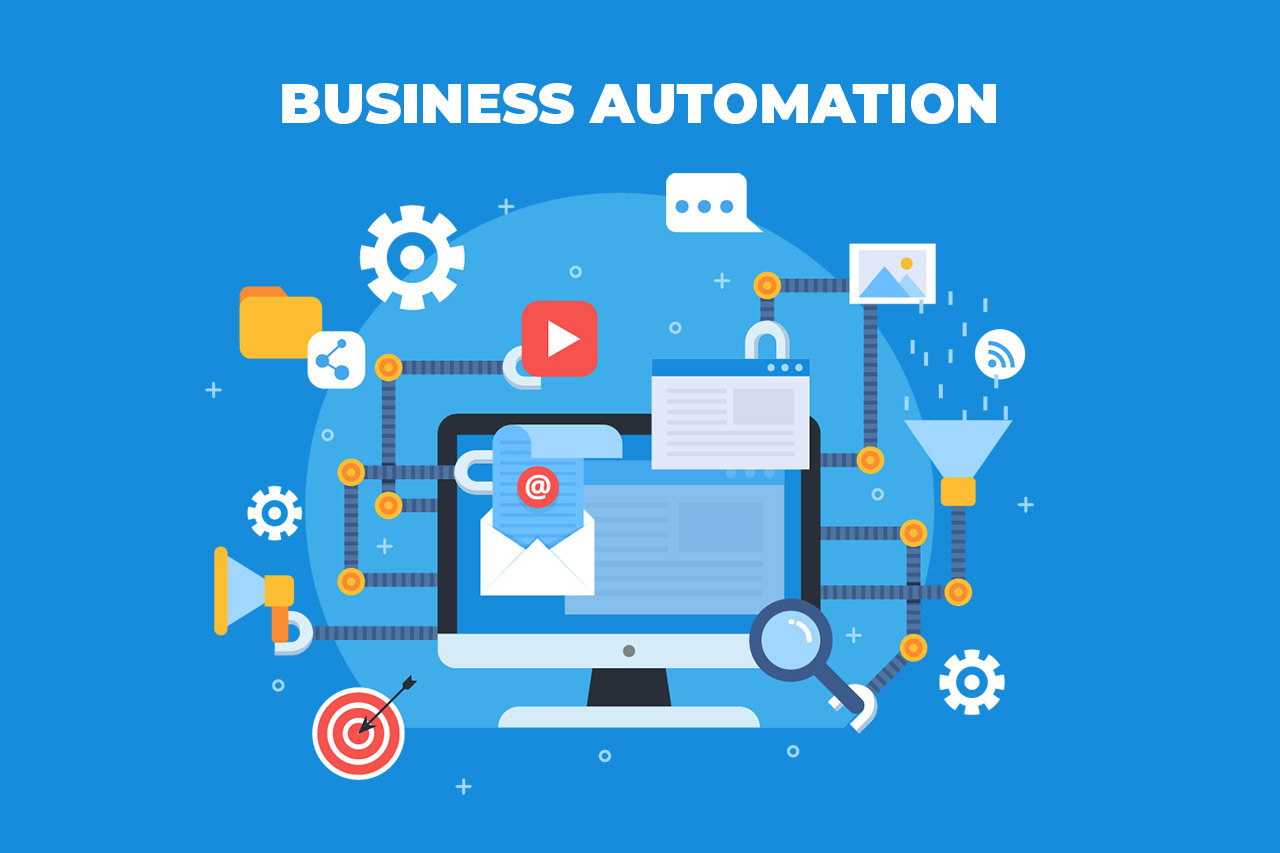For start-ups, a proactive business automation strategy is the key to success. Why? Because crafting a foundational automation strategy will save you time, increase productivity and ultimately allow you to scale faster.
When getting started, it’s important to carefully consider the costs and benefits of business process automation and choose the right tools and technologies to meet your specific needs. It’s equally crucial to have a clear plan on how to implement, manage, and optimize your automation and how to monitor its effectiveness over time.
In this article, you’ll learn some business process automation strategies, get a copy of our playbook, and understand how your start-up can use BPA to accomplish your goals and gain a competitive advantage.

Why is a Business Automation Strategy Important?
Many times, start-ups fail not because of bad ideas but primarily because of a lack of resources, inappropriate planning, and strategic execution. Too often, they do not have the human and financial capacity to compete fairly with large corporations in the same industry. But thanks to automation, new businesses can now achieve more with less human/financial capital.
Automation lets you do more in less time; streamlines your processes, and helps to scale your business without the need for cost-intensive resources.
Sounds interesting, right?
However, while business process automation is a great idea, not everyone gets the desired result. Why? There’s a right way to do it, and only those who do it right get the desired results. Before you jump on the automation bandwagon, you’ll need to have an effective strategy.
A well-designed automation strategy can help your start-up reduce costs and increase productivity. According to Forbes, businesses implementing the right automation strategies can save up to 75% on their operations.
So, would you need business strategy consultants to help navigate these waters or do you have the resources to pull the right automation strategy together for your business? You’ll have your answers when you read further.
How to Build an Effective Business Automation Strategy

Business automation offers many benefits, but successful implementation requires careful planning and strategic pivots. For a successful business automation strategy, there are 11 essential steps that startups need to take. From choosing the right tools and processes to determining how much they should automate. Let’s go through each:
1. Define Your Business Goals
Defining your business goals will help you identify ways automation can get you closer to achieving them. Talk to your team or hire a strategy consulting team to help clarify these goals before proceeding with your automation plans. Automation builds take a considerable amount of time and commitment and, hence, should be implemented with a specific goal in mind.
These could be optimizing marketing campaigns, reducing costs, increasing sales and revenue, enhancing service delivery, or improving overall business efficiency. Defining your goals will help you measure the success of your automation strategies.
2. Identify Processes to Automate
The prioritization of certain processes should be based on the objectives you defined earlier. Once you’ve identified the departments that are most important to your goals, automate and streamline the processes in those departments.
For example, if your goal is to increase lead generation and conversion, you may want to automate your nurture campaigns and marketing funnels.
3. Create Your Budget
Automation can quickly accumulate to a substantial sum over the long term. You must consider the financial state of your start-up before developing or implementing an automation plan.
First, figure out your needs and available resources, then create a budget based on that information. Also, other unexpected costs may arise as the automation progresses; ensure to make plans for them in your budget.
4. Evaluate Risks and Benefits
Business process automation is beneficial, but we’d be lying if we didn’t note that it also comes with a level of risk. Evaluate the benefits your start-up will derive from automating certain processes (instead of paying a human resource to do them) and whether they align with your short and long-term objectives. In the same manner, consider all the risks and implications of employing certain automation tools before moving forward.
For instance, a risk would be the time needed by your internal team to implement the change, migrate processes and train employees as needed.
5. Choose (The Right) Automation Tools
There are lots of business process automation tools and software out there, each one claiming to be the best. Do your research or get advice from a business strategy consultant before choosing any tool. Commit only to a business automation tool that best fits your current needs and budget, and can accommodate your future plans. Additionally, the tool must be intuitive, flexible, easy to use, and compatible with other tools.
6. Set Implementation Roadmap
Once you find the perfect automation tools, the next thing is to integrate them into your business systems and processes. Create a timeframe and roadmap that includes all the steps you may miss when you are implementing. This will help you define which processes are most important even further once you look at the timeframe for each visually. Automate all the menial, repetitive, time-consuming tasks that keep the employees busy and don’t allow them to open their creative flow.
7. Get Team Buy-In and Training
Introducing changes like process automation in the workplace, especially to start-up employees, is a big deal. At first, you may face resistance from team leads and employees in the organization who do not fully understand its benefits. Start by communicating how process automation improves efficiency, increases ROI, and saves time and energy that they can now put elsewhere (maybe that one project they are passionate about). Also, you must train them on how to comfortably and effectively use the new systems. Think about how this training should work for your company and if you have the resources to create and train your team.
8. Define Roles and Hierarchy
Once automation is implemented, employees may get confused about roles or become complacent with the handling of tasks. To prevent this, you must define the roles and responsibilities of each employee or team member involved in the process. It is also important to establish a hierarchy among team members to enforce accountability within the process. We advise setting a lead for each process that will document and own the documentation around it.
9. Monitor, Evaluate, and Improve Performance
Once your process automation is set up and your team members are actively using it, the next thing to do is monitor the tool or system and evaluate its performance periodically. Monitoring the system allows you to ensure the tool is performing while evaluating it allows you to measure the KPIs and results of your automation strategies. Since automation is a continuous process, you should always seek ways to improve the business automation strategies in your start-up.
10. Maintain a Flexible Approach
Business automation is not a “one size fits all” strategy. What works for another business might not work for your start-up. Business goals or plans can change, and growth may set in. Be flexible enough to experiment and adjust your automation tools and strategies as needed.
11. Optimize and Scale
As the pressure to remain competitive only grows stronger, it’s important not to overlook the importance of optimizing existing automation. Otherwise, you may find yourself losing valuable time and resources unnecessarily. Why take two steps when you can take one?
Make it a priority to regularly ensure that automated processes are functioning at their best as this will also help to quickly note areas where automation could be improved. Scaling is inevitable after properly implementing these steps, giving each one consideration, and executing rightly.
Benefits of Business Automation

Need help explaining why your business needs to automate processes to your team or potential investors? We got you. Business automation leads to:
- Increased Efficiency and Productivity: Automating repetitive tasks will save time and reduce errors, allowing employees to focus on more complex and valuable tasks. For example, automating the invoicing process at a start-up would save employees time, remove customer wait periods, and reduce the chance of miscalculation.
- Cost Savings: Automation can reduce labor costs and increase operational efficiency, leading to cost savings for your organization. For example, when a logistics company automates the scheduling and dispatching of its delivery trucks, labor costs will reduce.
- Improved Accuracy and Consistency: Automated processes ensure that tasks are completed consistently and accurately. For example, automating the process of onboarding new employees for a start-up would help to ensure that all necessary steps are completed consistently and accurately.
- Better Data Tracking and Analysis: Automated processes can generate data that is useful for tracking performance and used to make data-driven decisions. For example, automating the process of tracking inventory levels for a retail business would generate relevant data that will lead to the right decisions.
- Increased Scalability: Automation can make it easier for a start-up to scale its operations and manage growth opportunities. For example, creating and sending automated marketing emails will speed up the sales journey for your new contacts and leads.
- Improved Customer Service: Automation can help organizations respond more quickly and efficiently to customer inquiries and requests. For example, using a programmed chatbot to respond to customer inquiries will help you respond quickly, reduce churn rates, and improve relationships with customers.
- Better Compliance and Security: Automated processes and tech companies help organizations comply with regulations and ensure the security of sensitive data. For example, automating the process of data logging and managing tracking access for sensitive data would help your business comply with regulations and ensure the security of the data.
Disadvantages of Business Automation

While business process automation has its benefits, there are also some potential disadvantages to consider:
- Initial Costs: Implementing automation may not be as pocket-friendly as one thought in the beginning, especially if it requires new software or hardware.
- Job Loss: Automating certain tasks can result in the displacement of some employees, which can cause low morale and retention problems.
- Complexity: Automation can be a complex process and may require outside specialized knowledge and technical skills.
- Dependence On Technology: Automation relies on technology, which can sometimes malfunction.
- Limited Flexibility: Automation tools are designed to handle specific tasks and may not be able to adapt to unexpected situations or changing requirements.
- Lack of Human Touch: Automated processes may not be able to replicate the personal human touch that is sometimes needed to handle customer interactions.
- Limited Decision-Making Capabilities: Automation tools can only make decisions based on rules and triggers. This can limit the ability to implement the right processes in complex situations.
Where Your Start-up Can Leverage Automation

Despite these drawbacks, there is a clear advantage in leveraging automation technology and using a business automation strategy for your start-up from the get-go. So where is the best place to start?
1. Marketing
Marketing automation is the process of simplifying marketing tasks while maintaining a personal touch. Your start-up needs marketing automation if you intend to expand and don’t have the time to manually contact each lead. You’ll need to streamline complex marketing processes by creating segmented marketing funnels.
The two common parts of marketing automation, are the trigger, and the action. The first is the contact activity trigger, while the second is the marketing action. This means that whenever a trigger is activated, a contact goes through a series of automated marketing processes and is nudged to take action at different points.
2. Sales
The first step in automating your start-up’s sales process is determining which tasks should be automated. This should always include your lead capture and tracking, email and drip campaigns, contact management, and reporting and analytics. After you’ve decided on a sales automation tool, the next step is to integrate it into your sales process. Learn more on this in our playbook.
3. Human Resources
The HR department of a start-up is primarily reliant on paperwork, forms, and routines. It is hardly possible to grow your team without them. Use automation tools to create and review forms and applications, import documents, and review resumes and job applications. The right human resource automation tool will manage anything you may not have time to deal with while maintaining quality and accuracy.
Things to Consider When Choosing a Business Process Automation Tool

When considering a business process automation tool, there are several things to keep in mind:
- Business needs: The tool should be able to meet the specific needs of the start-up and automate the processes that will bring the most value.
- Scalability: The tool should be able to help scale your start-up and adapt to changing needs.
- Integration: The tool should integrate seamlessly with multiple existing systems and software, such as CRMs and ERP systems.
- User-friendliness: The tool should be easy to use and require minimal training for employees.
- Data security: The tool should have robust security features to protect sensitive business data.
- Customization: The tool should be customizable to match the specific needs of the start-up.
- Technical support: The tool should have good technical support and documentation to help with implementation and troubleshooting.
- Cost: The tool should be cost-effective and provide a good return on investment.
- Flexibility: The tool should be flexible enough to adapt to changing business requirements.
- Reporting and analytics: The tool should provide reporting and analytics capabilities to measure the performance of the automated processes.
Business Process Automation Tools to Consider
There are several business automation tools that start-ups can use to improve the efficiency of processes and scale their businesses. Here are some of the most common business automation tools:
1. Pipefy
Pipefy is a powerful workflow platform designed to help businesses streamline and optimize their operations. At its core, it allows users to create automated workflows for various tasks, such as onboarding new employees or managing customer service inquiries. With Pipefy, you can customize your workflows to fit your exact needs and ensure that tasks are completed on time with minimal effort or disruption. It also provides users with advanced analytics so they can measure performance and make informed decisions about how to improve processes.
Features:
- Flexible Workflow Management Tool
- Drag-and-Drop Interface
- Built-in Templates
- Real-time Visibility into Tasks Status
- Seamless Integration with Popular Business Applications
- Project Tracking and Management
- Free Trial Period
Pros
- Great Tool for Organizing Thoughts and Ideas
- Easy to Use
- Helps to Stay on Track
- Manages Time and Resources
- Flexible and Adaptable
- Great Tool for Collaboration and Communication
Cons
- Subscription is not Free
- Limited Storage Space
- No Mobile App
2. Ontraport
Ontraport is a no-code business automation platform that assists firms in scaling and automating their processes. Ontraport organizes and automates the whole purchase cycle, allowing teams and start-up owners to focus on providing more value to customers. Start-ups can automate their marketing, sales, and other business processes with Ontraport.
Features:
- Email, online, and Social Media Marketing
- Task Scheduling and Management
- Customizable Branding
- Lead Management
- Reporting and Analytics
- Campaign Management
- Customer Service
Pros
- Easy to Use
- Value for Money
- Has Powerful Tools and Features
- Offers Quality Support
Cons
- UI/UX needs improvement
- Slow Response
3. Zapier
Zapier is an online tool that connects your favorite apps and services to automate processes. Start-ups can automate tasks as a result without having to create the integration yourself or hire a developer. Zapier gives you the ability to automate your work across 5,000+ apps so you can advance more quickly.
Features:
- Sales and Email Management
- Online and Social Media Marketing
- Business Process Automation
- Usage Tracking and Analytics
- Workflow and Task Management
- Customer Service
Pros
- Easy to Use
- Excellent Integration with Other Apps
- Offers Quality Support
Cons
- Pricing Structure Can be Better
- UI/UX Needs Improvement
4. HubSpot
HubSpot allows start-ups to automate workflows and execute their business processes in one place. It features a traditional CRM that allows start-ups to track all customers’ contact points, while also creating emails and landing pages for lead generation. Whether you’re a small or medium size start-up in e-commerce, tech, real estate, higher learning, or non-profit, HubSpot has everything you need to successfully scale your business.
Features:
- Email Marketing
- Online and Social Media Marketing
- Lead management
- Reporting and Analytics
- Campaign Management
- Customer Service
Pros
- Easy to Use
- Excellent Reporting and Analytics Tool
- Offers Quality Support
Cons
- Not the Cheapest Option
Why You Should Work with Business Strategy Consultants

As a start-up leader or founder, you may get overwhelmed trying to figure out the best automation strategy for your company and how to effectively implement it to drive the desired results. When faced with this type of challenge, talk to business strategy consultants that are genuinely interested in the growth of your business and ready to help you achieve your goals and objectives. Here are some of the ways you can benefit from working with business strategy consultants as you look to implement automation strategies in your business processes:
- Identifying opportunities: Consultants can help start-ups identify areas of the business that would benefit most from automation, such as repetitive tasks, data-intensive processes, or customer interactions.
- Assessing feasibility: Business strategy consultants can assess the feasibility of automating specific processes and help you determine whether automation is a viable solution.
- Developing a plan: Once you’ve identified the processes that should be automated, a consultant can help develop a plan for implementing automation. This may include identifying the technologies and tools that will be needed and creating a roadmap for implementation.
- Managing the implementation: Business strategy consultants can help you manage and improve your automated processes, which may involve working with internal teams or external vendors.
- Managing the transition: Automating processes can lead to changes in the way your start-up operates. Business automation consultants can help you manage the transition and ensure that employees are trained and prepared for the changes.
- Monitoring and evaluating: Consultants can help you monitor and evaluate the performance of the automated processes while making adjustments where and when needed.
- Cost-benefit analysis: A business strategy consultant has the relevant experience to create a cost-benefit analysis, evaluate the financial impact of automation on your business, and decide on whether to implement it or not.
Parting Thoughts
Automating your business operations has a wealth of advantages – from improved performance and reliability to greater productivity, efficiency, and cost savings. New tools and technologies are making it possible to save time and effort that could have been wasted on mundane, repetitive tasks such as typing and data entry. Leveraging the use of business process automation will allow start-ups to enhance their service delivery, use and learn from the data available, make informed business decisions, and get a fair chance to compete with similar businesses. Need to talk to a business automation consultant? Book a free call with us.


